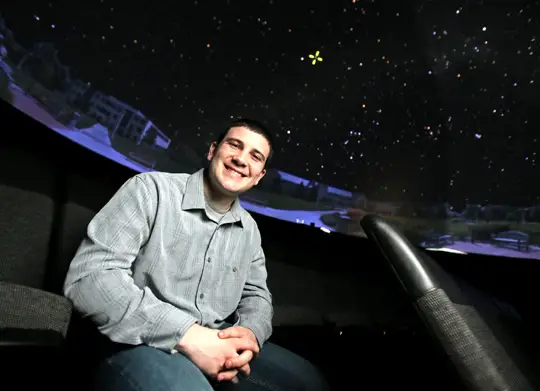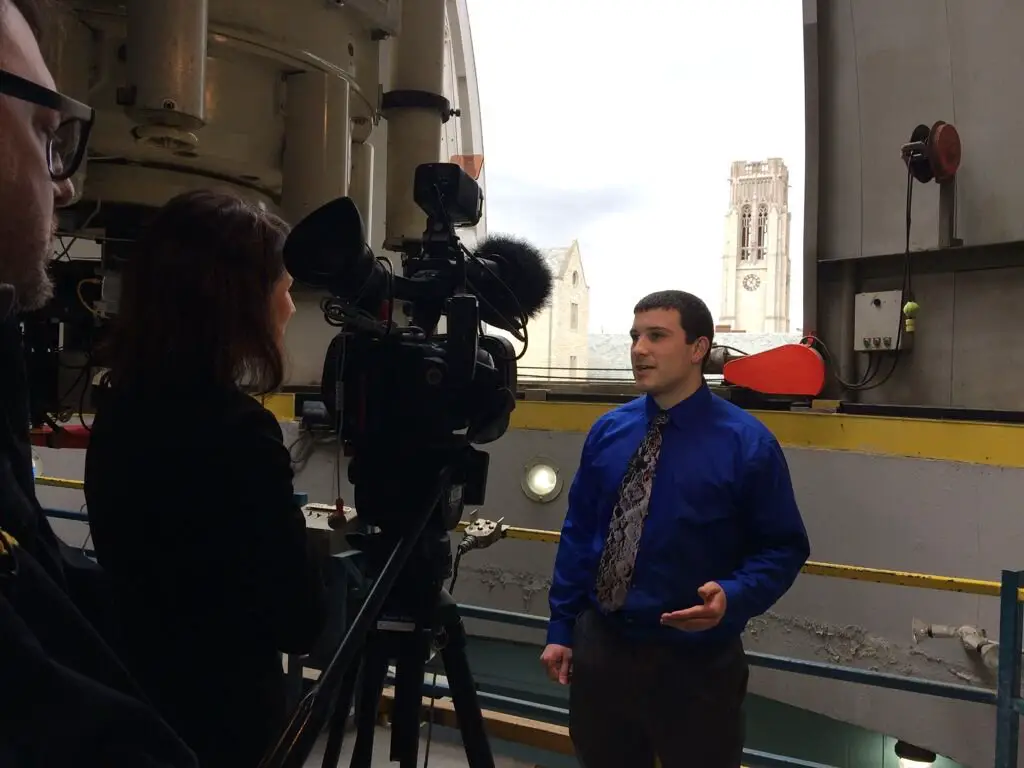Senior Astrophysics major Nick Dulaney made an exciting discovery last year. Then a sophomore at the University of Toledo in Ohio, Dulaney is responsible for discovering that the star Beta Canis Minoris was actually two stars, one orbiting the other.
It was his fascination with the stars that led Dulaney to the University of Toledo in the first place, as, in addition to being relatively close to home, the university is the operator of the Ritter Observatory and Planetarium. Since 1968, the observatory has been dedicated to researching the cosmos and is home to both conventional and spectroscopic telescopes. After receiving a tour of the university and being impressed by Toledo’s world class Physics program, he knew what he needed to do.
After graduating from Dalton High School, Dulaney applied to and was accepted into the University of Toledo’s Physics program with a focus on Astrophysics and a minor in Mathematics. While all the university faculty were helpful and clearly as enamored with the stars as he was, Dulaney quickly found a mentor in Rick Erving. “He basically keeps the department running,” says Dulaney about Erving. “He does so many things to help the professors and students, he’s the one who gave me my first tour.”
For those unfamiliar with the terminology, astrophysics both is and is not the same thing as astronomy, depending on how you choose to look at it. While the terms are often used interchangeably even by those within the field, astrophysicists not only identify and catalog the positioning, movement and other behaviors of stars, plants, and various celestial objects, but try to find emanations for those positions and behaviors. Dulaney’s unquenchable thirst for knowledge helped him greatly in this highly technical field. In spring 2016, the then-sophomore had a chance to prove himself by investigating the strange behavior of Beta Minoris.

The discovery of the dwarf star was not an accident, but instead the result of many months of hard work. Beta Canis Minoris is not a normal star, as it exhibited unusual behaviors that made the presence of another celestial body likely. The star is surrounded by what’s known as an accretion disk—a close orbiting cloud of gasses and particles. As the name implies, the cloud is often flat and surrounds the star in a similar way to Saturn’s rings.
While having a gaseous ring is hardly unique among the hundred billion stars in the Milky Way, but by the way it looks, it is in fact one of kind. While it is not possible to detect with the naked eye or even a high-powered conventional telescope, the ring itself is oddly truncated. The gravity from Beta Canis Minoris should make the accretion disk an almost perfect circle radiating evenly from the star. However, examination with high-powered telescopes showed that there was clearly a bulge in the disk. There must have been something pulling the matter that makes up the disk to one side, but finding it would be no easy task.
Astronomers were pretty sure that some large object was responsible for the unusual behavior of Beta Minoris’ accretion disk. The presence of a dwarf star, one much smaller than the Sun but several orders of magnitude larger than Jupiter, seemed likely and had been the inferred explanation for some time, but no one had yet been able to definitively prove that hypothesis. With the help of post-doctoral researcher Noel Richardson, the observatory director and funding from the National Science Foundation, Dulaney was determined to find the answer, once and for all, to prove the existence of the dwarf star.
The most famous depiction of a binary star system is the two suns of Tatooine in Star Wars. While systems of two co-orbiting stars of roughly equal mass do exist, the majority of multi-storm systems consist of a single, medium-sized star being orbited by one or more smaller stars. Given the comparative size and closeness and the fact that many dwarf stars, called brown dwarfs, do not emit visible light, it is common for orbiting stars to be lost in the glow of the parent star.
The process of finding the star would be a slow one, taking hundreds of hours and several months. Because of the distances involved, the dwarf star is not directly visible from Earth even with the most advanced electron microscopes. Fortunately, the Ritter observatory is equipped with a spectrographic telescope, which measures the frequency of the light and the radiation stars emit.
After combing through over a decade of archival data, Dulaney noticed that the light from Beta Canis Minoris fluctuates in color and the star itself wobbles in a slight but measurable way. Both of these phenomena are the result of the gravity of the two stars pulling on each other in a similar manner to how the Earth and Moon interact creating tides.
With this discovery, Dulaney finally had the evidence he needed to definitively prove the existence of a white dwarf star orbiting Beta Canis Minoris. “I want to thank the school, my professors for guidance along the way and the National Science Foundation for funding the research,” says Dulaney.
Now in his senior year, Dulaney continues to work toward a career in astrophysics. Being responsible for such a major discovery at such a young age, the future for Nick Dulaney looks bright indeed.

















